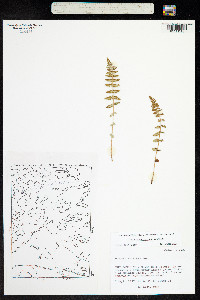Woodsia neomexicana
|
|
|
|
Family: Woodsiaceae
New Mexico Cliff Fern
|
Stems compact, erect to ascending, with few to many persistent petiole bases of unequal lengths; scales mostly uniformly brown but at least some bicolored with dark central stripe and pale brown margins, narrowly lanceolate. Leaves 4--30 × 1.5--6 cm. Petiole light brown or straw-colored when mature, occasionally darker at very base, not articulate above base, relatively brittle and easily shattered. Blade linear to lanceolate, usually pinnate-pinnatifid proximally, glabrescent to sparsely glandular, never viscid; glandular hairs with thin stalks and slightly expanded tips; rachis with scattered glandular hairs and rare, hairlike scales. Pinnae ovate-deltate to elliptic, longer than wide, abruptly tapered to a rounded or broadly acute apex; largest pinnae with 3--7 pairs of closely spaced pinnules; abaxial and adaxial surfaces glabrescent to sparsely glandular, lacking nonglandular hairs or scales. Pinnules dentate, often shallowly lobed; margins nonlustrous, thin, with occasional glands, lacking cilia, with 1--2-celled translucent projections on teeth. Vein tips occasionally enlarged to form whitish hydathodes visible adaxially. Indusia of narrow, filamentous segments, these uniseriate for most of length, composed of ± isodiametric cells, usually surpassing mature sporangia. Spores averaging 44--52 µm. 2 n = 152. Sporulating summer--fall. Cliffs and rocky slopes; usually on sandstone or igneous substrates; 300--3500 m; Ariz., Colo., N.Mex., Okla., S.Dak., Tex. Woodsia neomexicana traditionally has been identified as W . mexicana . Both taxa are tetraploid and may share one parent (M. D. Windham 1993); W . neomexicana is separated from typical W . mexicana by its completely filamentous indusial segments, reduced glandularity, and more northerly distribution. Isozyme data suggest that W . neomexicana is an allotetraploid hybrid between W . phillipsii and the diploid progenitor of W . oregana subsp. cathcartiana (M. D. Windham 1993). As with all allopolyploids, W . neomexicana can vary in the direction of either parent, and some plants (especially those resembling W . phillipsii ) can be difficult to identify. All characters except those controlled directly by ploidy level show this tendency, and spore size remains the most dependable character for distinguishing W . phillipsii and W . neomexicana . This species hybridizes with W . oregana subsp. cathcartiana and W . phillipsii to produce sterile tetraploids and triploids, respectively.
FNA 1993, Kearney and Peebles 1969, Allred and Ivey 2012, Martin and Hutchins 1980, Heil et al. 2013 Common Name: New Mexico cliff fern General: Small fern, 4-30 cm tall, from compact, erect to ascending rhizomes; rhizomes covered with brown scales mixed with occasional bicolored scales which are light brown with a dark central stripe. Leaves: A cluster of fronds emerges directly from the rhizome, mixed with persistent petioles from previous years; petioles straw-colored, brittle and easily broken; blade lanceolate in outline, 1-6 cm wide, and pinnately compound, with 8-20 piairs of pinna (i.e. leaflets); leaflets ovate to slightly triangular in outline and pinnately lobed, the lobes in turn having finely crenate margins; leaflet surfaces mostly glabrous or with scattered glandular hairs. Sporangia: Sori (clusters of sporangia) line the edges of the leafets; protected by indusia of narrow filamentous segments. Ecology: Found on cliffs and rocky slopes, usually on sandstone or igneous substrates, from 3,000-11,500 ft (1067-3505 m); sporulates June-October. Distribution: s CO, AZ, NM, w OK, w TX; disjunct in SD Notes: In older texts this species is sometimes described using the name Woodsia mexicana, a similar species that according to Flora of North America does not grow north of the US-Mexico border. W. neomexicana was recently separated from W. phillipsii; the best way to distinguish between those two species without a microscope is by the shape of the pinna (leaflets); W. neomexicana has leaflets that are wider, ovate to ovate-triangular in outline; W. phillipsii has narrower leaflets, which are linear or narrowly elongate-triangular in outline. The leaflets in both species are pinnately lobed, and the margins of the lobes are finely crenate (with small rounded teeth). The genus Woodsia has been pushed around quite a bit, taxonomically. Currently placed in Woodsiaceae, you may need to look for it under Dryopteridaceae or Polypodiaceae, even in even relatively new texts. Ethnobotany: An infusion of the plant used as a douche at childbirth; also used ceremonially as a Life Medicine. Etymology: Woodsia is named after Joseph Woods (1776-1864) an English botanical author; neomexicana means of or from New Mexico. Synonyms: None Editor: SBuckley 2010, AHazelton 2017 |
|
|
|






























































































